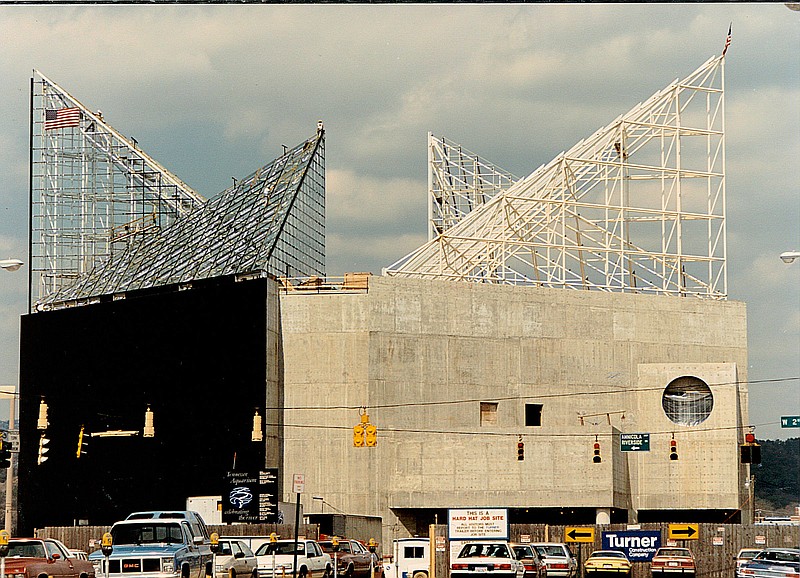Fishing for dollars
Since its opening 25 years ago, the Tennessee Aquarium has attracted:* 23 million visitors* $3.29 billion of economic impact for Hamilton County* $189.6 million in state and local tax revenuesSource: University of Tennessee at Knoxville’s Center for Sustainable Business and Development. Estimates based on people surveyed who said their primary reason to visit Chattanooga was the Tennessee Aquarium
In the 25 years since its glass peaks were raised above the Tennessee River to frame Chattanooga's skyline, the Tennessee Aquarium has been at the epicenter of the city's downtown revival.
Since its opening on May 1, 1992, more than 23 million people have visited what has become the region's biggest attraction.
A new economic study estimates those visitors have pumped nearly $3.3 billion into Hamilton County's economy and helped spur more than $5 billion in private investment downtown.
Last year alone, out-of-state tourists coming to visit the Tennessee Aquarium are estimated to have had an economic impact totaling $115.7 million, according to a study by the University of Tennessee's Center for Sustainable Business and Development.
"The opening of the aquarium was really the beginning of the renaissance of our city," said Bob Doak, president of the Chattanooga Area Convention and Visitors Bureau. "The vision our community leaders had to transform our city began with the aquarium, and without the aquarium we would not be where we are today."
The initial success of the community-backed attraction helped not only to expand the mission and scope of the world's largest freshwater aquarium, it helped revive the downtown waterfront and encourage the building of dozens of restaurants, shops, hotels and other tourist-oriented attractions.
"Before the aquarium was built, when I left work some nights there wouldn't be a soul on Broad or Market streets,' said Keith Sanford, the former Chattanooga market president of First Tennessee Bank who was a charter member of the aquarium and became its president last year. "Today, those downtown streets are filled with people, even on most weeknights, and a lot of that has to do with what began with the aquarium."
Mitch Patel, president of Chattanooga-based Vision Hospitality Corp., credits the aquarium for much of the growth in the city's $1 billion-a-year tourism industry.
"Before the aquarium opened 25 years ago, Chattanooga was known as a place where tourists would stop on their way to Florida and maybe see Rock City and Ruby Falls on [Lookout] mountain," Patel recalled.
"But it was not a destination tourist city like it has become. The aquarium and those who had the vision to make it happen were key to helping make Chattanooga the place it is today, where people want to come and stay for a few days or even move to and live."
Vision Hospitality is building its ninth hotel in Hamilton County, among its nearly three dozen properties across five states.
As a catalyst for growth, the aquarium and other attractions helped to increase the hotel business in Hamilton County nearly fourfold. In 1991, the last full year before the aquarium opened, Hamilton County hotels captured $47 million in total revenues. Last year they generated $187 million in revenues, according to the Hamilton County Trustee's Office.
Before the aquarium opened, the only major hotel built downtown in decades was the Marriott, which that opened in 1986 next to the Trade Center. Since 1992, more than a dozen hotels have been added across Chattanooga, and more than $140 million in new hotels are being built or in the pipeline in Hamilton County, including five luxury or boutique hotels downtown.
"Jack's fish tank" questioned
Some were initially skeptical of the aquarium idea, which was proposed by architectural students at the Urban Design Studio in 1981 and later embraced as one of the goals in the community planning process organized by Chattanooga Venture in the 1980s.
When the aquarium was pitched to then-Tennessee Gov. Lamar Alexander among a group of community projects, he urged local leaders, including Chattanooga Coca-Cola magnate Jack Lupton, to make the attraction distinctive and world-class.
When anti-tax activists such as Edna Taylor questioned the need for taxpayer funding and derided the project as "Jack Lupton's fish tank, " Lupton and other backers agreed to build it with private money. Lupton, chairman of the Lyndhurst Foundation, contributed $10 million from the foundation and $11 million of his own money, and he led the $45 million fundraising drive.
The Tennessee Aquarium was designed by Cambridge Seven Associates, which had previously designed the National Aquarium in Baltimore and the New England Aquarium in Boston, to tell the story of aquatic life from the headwaters of the Smoky Mountains to the Gulf of Mexico. The 130,000-square-foot River Journey structure is the equivalent of a 12-story building and follows the path of a raindrop from high in the Appalachian Mountains to the ocean.
Many of its tanks and exhibits bear the names of corporate or individual donors. Memberships, admission fees and ongoing capital campaigns help pay to operate and expand the aquarium and support its educational research and outreach.
The 21st Century Waterfront, which included the $30 million Ocean Journey structure built in 2005, revamped the Ross's Landing are to include a riverfront park, walkway, pier and boat docks, opening up the waterfront to pedestrians and Chattanooga's downtown to boats.
The aquarium quickly won over most skeptics, topping its first-year attendance goal of 650,000 people within its first four months and topping out at nearly 1.5 million visitors in the first year. It consistently has ranked among the nation's top aquariums in visitor satisfaction surveys.
Aquarium additions expand appeal
During the Tennessee Aquarium's dedication ceremony, then-Chattanooga Mayor Gene Roberts proclaimed the opening day "a magical moment" in the city's history.
"The aquarium will establish us as men and women who celebrate clean water and clean air as the lifeblood which sustains us," Roberts said.
The aquarium's educational and research mission has expanded its scope and footprint to add research and conservation institutes and extra attractions, such as the IMAX Theater, Ocean Discovery saltwater tanks and the River Gorge Explorer boat trips in the Tennessee River gorge.
"There are other aquariums that are bigger, but we believe we are the best," Sanford said.
The Chattanooga aquarium has remained distinctive in its focus on river aquatic life and its unique display of the Appalachian region.
"Before the Tennessee Aquarium, no one had ever seen below the surface of the rivers, streams and lakes we're surrounded by," said Cindy Todd, chief marketing and development officer. "I spend a lot of time swimming, skiing and paddling on the lake, and I'll never forget the first time I saw the aquarium's Nickajack Lake exhibit."
Aquarium competition grows
The Tennessee Aquarium has faced regional competition and has not ever surpassed its first-year attendance. Ripley's Aquarium of the Smokies opened in Gatlinburg in 1997, and the $250 million Georgia Aquarium opened in Atlanta in 2005 as the world's largest aquarium.
Those attractions, especially the Atlanta facility, have cut into attendance at the Tennessee Aquarium. In response, the local facility added saltwater exhibits in the $30 million Ocean Journey attraction in 2005.
But the aquarium has maintained its financial footing with added attractions and expanded merchandise sales.
Building on success
Chattanooga downtown boosters also have added to its appeal with the development of Coolidge, Renaissance and the Tennessee Riverwalk parks; the Children's Discovery Museum; the Walnut Street and Holmberg pedestrian bridges; the AT&T baseball stadium for the Chattanooga Lookouts, the expansion of the Hunter Museum of American Art and growth of the Bluff View Art District, among other successes.
"Because the aquarium was so successful, it gave the city the confidence to be bold and it really set the stage for how we do other projects," said Kim White, president of River City Co..
"There has been $5 billion of private investment in our downtown area since 1992, including a billion dollars of projects announced in the past year and a half. That's just extraordinary, but it shows the power of finding what is authentic and fits your community. That's what the aquarium has been for Chattanooga."
Contact Dave Flessner at dflessner@timesfreepress.com or 423-757-6340.
Music, prizes, parade mark 25th anniversary Saturday
To celebrate its silver anniversary, the Tennessee Aquarium plans an all-day celebration on Saturday at the Chattanooga River Market with music, prizes and parades.Celebration attendees can take in musical performances by local artists Rick Rushing (11:30 a.m.-2 p.m.) and Kofi Mawuko (2:30-4:30 p.m.) and peruse the wares of numerous vendors at the Chattanooga River Market. Throughout the day prizes will be given away, and aquarium mascots will welcome visitors and pose for photos.At 9:30 a.m., fabulously festooned art cars will gather in the aquarium parking lot and there will be a special parade of children’s art cars created by Hamilton County students. The outdoor festivities will end by 5 p.m. The aquarium will be open during normal operating hours — 10 a.m. to 6 p.m. — throughout the celebration.On Thursday night, the aquarium will toast the many achievements of its first 25 years during a fundraiser billed as “Spring!” The dinner and social gathering will take place on the Walnut Street Bridge and include a toast to the community and one another as attendees are seated together at a massive 480-foot-long dining board comprised of 60 individual tables laid end to end on the Walnut Street Bridge.
Aquarium at a glance
Location: 1 Broad Street on Chattanooga’s downtown waterfrontDistinction: The world’s largest freshwater aquariumOwnership: Nonprofit agency governed by a 20-member boardCEO: Keith SanfordStaff: More than 200 paid employees and over 750 volunteersAnimals: Home to more than 12,000 animals representing almost 800 speciesAnnual revenues: $25.2 millionWeb address: www.tnaqua.org
Aquarium additions
1992 - River Journey opens as the world’s largest freshwater aquarium1996 - IMAX theater opens1996 - Environmental learning Lab opens1998 - Plaza concessions added2000 - Ticketing center opens in the former Visitors Center2005 - Ocean Journey opens with saltwater additions to aquarium display2008 - River Gorge Explorer begins riverboat trips on the Tennessee River2015 - Imax theater installs digital laser projection system2016 - Conservation Institute opens on the Tennessee River near Baylor School

